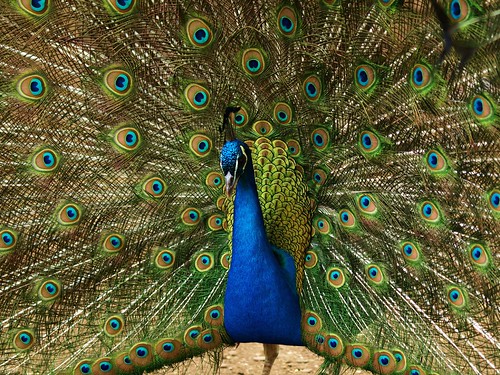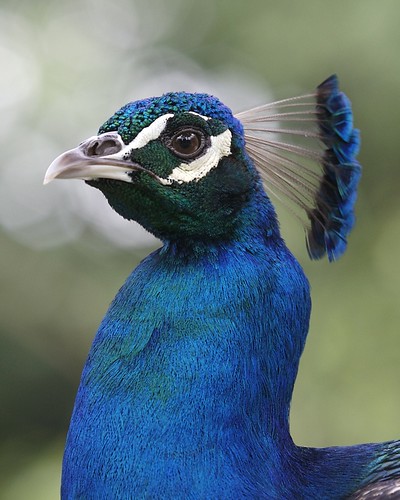The Indian Peafowl, Pavo cristatus, also known as the Common Peafowl or the Blue Peafowl, is one of the species of bird in the genus Pavo of the Phasianidae family known as peafowl. The Indian Peafowl is a resident breeder in the Indian subcontinent and has been introduced into many parts of the world and feral populations exist in many introduced regions. The peacock is the national bird of India.
The species is found in dry semi-desert grasslands, scrub and deciduous forests. It forages and nests on the ground but roosts on top of trees. It eats seeds, insects, fruits, small mammals and reptiles.
Females are about 86 cm (34 in) long and weigh 2.75-4 kg (6-8.8 lbs), while males average at about 2.12 m (7.3 ft) in full breeding plumage (107 cm/42 in when not) and weigh 4-6 kg (8.8-13.2 lbs). The male is called a peacock, the female a peahen. The Indian Peacock has iridescent blue-green plumage. The upper tail coverts on its back are elongated and ornate with an eye at the end of each feather.
These are the Peacock's display feathers. The female plumage is a mixture of dull green, grey and iridescent blue, with the greenish-grey predominating. In the breeding season, females stand apart by lacking the long 'tail feathers' also known as train, and in the non-breeding season they can be distinguished from males by the green colour of the neck as opposed to the blue on the males.
The species is found in dry semi-desert grasslands, scrub and deciduous forests. It forages and nests on the ground but roosts on top of trees. It eats seeds, insects, fruits, small mammals and reptiles.
Females are about 86 cm (34 in) long and weigh 2.75-4 kg (6-8.8 lbs), while males average at about 2.12 m (7.3 ft) in full breeding plumage (107 cm/42 in when not) and weigh 4-6 kg (8.8-13.2 lbs). The male is called a peacock, the female a peahen. The Indian Peacock has iridescent blue-green plumage. The upper tail coverts on its back are elongated and ornate with an eye at the end of each feather.
These are the Peacock's display feathers. The female plumage is a mixture of dull green, grey and iridescent blue, with the greenish-grey predominating. In the breeding season, females stand apart by lacking the long 'tail feathers' also known as train, and in the non-breeding season they can be distinguished from males by the green colour of the neck as opposed to the blue on the males.
Peafowl are most notable for the male's extravagant display feathers which, despite actually growing from their back, are known as a 'tail' or train. This train is in reality not the tail but the enormously elongated upper tail coverts. The tail itself is brown and short as in the peahen. The colours result from the micro-structure of the feathers and the resulting optical phenomena.
The ornate train is believed to be the result of female sexual selection as males raised the feathers into a fan and quiver it as part of courtship display. Many studies have suggested that the quality of train is an honest signal of the condition of males and that peahens select males on the basis of their plumage. More recent studies however, suggest that other cues may be involved in mate selection by peahens.
They lay a clutch of 4-8 eggs which take 28 days to hatch. The eggs are light brown and are laid every other day usually in the afternoon. The male does not assist with the rearing, and is polygamous with up to six hens.
The ornate train is believed to be the result of female sexual selection as males raised the feathers into a fan and quiver it as part of courtship display. Many studies have suggested that the quality of train is an honest signal of the condition of males and that peahens select males on the basis of their plumage. More recent studies however, suggest that other cues may be involved in mate selection by peahens.
They lay a clutch of 4-8 eggs which take 28 days to hatch. The eggs are light brown and are laid every other day usually in the afternoon. The male does not assist with the rearing, and is polygamous with up to six hens.





No comments:
Post a Comment